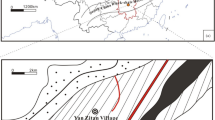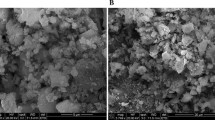Abstract
The shale instability is a great challenge for both conventional and unconventional hydrocarbon exploitation. Although numerous chemical inhibitor additives have been used to reduce shale swelling, the efficacy of each additive may vary in field conditions due to the heterogeneous nature of the shales, in terms of mineralogy, chemistry, microstructure, etc. Therefore, a special study for in-field inhibitor implementation is essential. The traditional additives including potassium chloride, polyamine, partially hydrolyzed polyacrylamide, and formulated novel chemical swelling inhibitors were used to carry out extensive laboratory investigations on shale inhibition. The formulated polyamine and xantham gum-based inhibiors acted as the most effective inhibitor to control the swelling up to 40%. The X-ray diffraction studies reveal the shale types, microstructures, chemistry, and their control on inhibition behavior. The montmorillonite-rich shales are significantly hydratable and expansive, while organic matter shows a negative correlation with shale swelling.
Graphical abstract

Highlights
-
The roles of different chemical inhibitors are investigated for different types of shales.
-
Microcomputer tomography and linear swelling meter are used to understand the internal shale microstructure and shale-inhibitor interactions.
-
Formulated efficient inhibition for reducing shale swelling mechanism to improve shale stability.
Discussion
The use of chemical additives in shale drilling fluids raises concerns about the environmental impact of extraction processes, emphasizing the need for sustainable alternatives and eco-friendly practices in the energy industry. The identification of novel chemical additives prompts discussions on the role of governmental policies and regulations in ensuring the responsible use of these substances, addressing potential environmental and health risks associated with shale exploration and drilling. Controversies may arise regarding the economic feasibility and long-term sustainability of adopting new shale swelling inhibitors, requiring a delicate balance between economic interests, technological advancements, and environmental responsibility within the energy sector.








Similar content being viewed by others
Data availability
The data linked to the manuscript will be made available whenever it is needed.
References
L. Chen et al., Mechanisms of shale gas adsorption: evidence from thermodynamics and kinetics study of methane adsorption on shale. Chem. Eng. J. 361, 559–570 (2019). https://doi.org/10.1016/j.cej.2018.11.185
D.M. Jarvie, R.J. Hill, T.E. Ruble, R.M. Pollastro, Unconventional shale-gas systems: the Mississippian Barnett Shale of north-central Texas as one model for thermogenic shale-gas assessment. Am. Assoc. Pet. Geol. Bull. 91(4), 475–499 (2007). https://doi.org/10.1306/12190606068
J. Bellani, H.K. Verma, D. Khatri, D. Makwana, M. Shah, Shale gas: a step toward sustainable energy future. J. Pet. Explor. Prod. (2021). https://doi.org/10.1007/s13202-021-01157-7
R.L. Anderson, I. Ratcliffe, H.C. Greenwell, P.A. Williams, S. Cliffe, P.V. Coveney, Clay swelling—a challenge in the oilfield. Earth-Sci. Rev. 98(3), 201–216 (2010). https://doi.org/10.1016/j.earscirev.2009.11.003
A. Kumar, R. Singh, V. N. Rai, and V. Sharma, “Challenges associated with drilling hydrostatic/subhydrostatic reservoir: Fluid engineering aspect *,” vol. 40744, pp. 12–14, 2011.
A.K. Abbas, R.E. Flori, A. AL-Anssari, M. Alsaba, Laboratory analysis to assess shale stability for the Zubair Formation, Southern Iraq. J. Nat. Gas Sci. Eng. 56(315–323), 2018 (2018). https://doi.org/10.1016/j.jngse.2018.05.041
A.M. Dayal, Chapter 1—Shale, in Shale gas. ed. by A.M. Dayal, D. Mani (Elsevier, Amsterdam, 2017), pp.1–11
H.H. Murray, Traditional and new applications for kaolin, smectite, and palygorskite: a general overview. Appl. Clay Sci. 17(5), 207–221 (2000). https://doi.org/10.1016/S0169-1317(00)00016-8
A. Rana, M.K. Arfaj, T.A. Saleh, Advanced developments in shale inhibitors for oil production with low environmental footprints—a review. Fuel 247(March), 237–249 (2019). https://doi.org/10.1016/j.fuel.2019.03.006
M.N.J. Al-Awad, B.G.D. Smart, Characterization of shale-drilling fluid interaction mechanisms related to wellbore instability. J. King Saud Univ. Eng. Sci. 8(2), 187–214 (1996). https://doi.org/10.1016/S1018-3639(18)30657-3
J. Guo, J. Yan, W. Fan, H. Zhang, Applications of strongly inhibitive silicate-based drilling fluids in troublesome shale formations in Sudan. J. Pet. Sci. Eng. 50(3), 195–203 (2006). https://doi.org/10.1016/j.petrol.2005.12.006
M. Yu, M.E. Chenevert, M.M. Sharma, Chemical–mechanical wellbore instability model for shales: accounting for solute diffusion. J. Pet. Sci. Eng. 38(3), 131–143 (2003). https://doi.org/10.1016/S0920-4105(03)00027-5
S. Kumar, A. Thakur, N. Kumar, M.M. Husein, A novel oil-in-water drilling mud formulated with extracts from Indian mango seed oil. Pet. Sci. 17(1), 196–210 (2020). https://doi.org/10.1007/s12182-019-00371-7
S. Gou, T. Yin, Q. Xia, Q. Guo, Biodegradable polyethylene glycol-based ionic liquids for effective inhibition of shale hydration. RSC Adv. 5(41), 32064–32071 (2015)
Y. An, G. Jiang, Y. Ren, L. Zhang, Y. Qi, Q. Ge, An environmental friendly and biodegradable shale inhibitor based on chitosan quaternary ammonium salt. J. Pet. Sci. Eng. 135, 253–260 (2015). https://doi.org/10.1016/j.petrol.2015.09.005
V.I. Osipov, Structural bonds and the properties of clays. Bull. Int. Assoc. Eng. Geol. 12(1), 13–20 (1975). https://doi.org/10.1007/bf02635423
K. Kishore and P. Rajalingam, “The Bonding,” vol. 24, pp. 471–476, 1986.
S. Banerjee, Z.R. Abdulsattar, K. Agim, R.H. Lane, B. Hascakir, Mechanism of polymer adsorption on shale surfaces: effect of polymer type and presence of monovalent and divalent salts. Petroleum 3(3), 384–390 (2017). https://doi.org/10.1016/j.petlm.2017.04.002
A. Boruah, B.K. Prusty, Influence of mineralogy, organic matter and thermal maturity on the diagenetic evolution of pore systems in the shales of Cambay and Raniganj Basin, India. J. Geol. Soc. India 99(11), 1577–1585 (2023)
A. Boruah, S. Ganapathi, Organic richness and gas generation potential of Permian Barren Measures from Raniganj field, West Bengal, India. J. Earth Syst. Sci. 124, 1063–1074 (2015)
Acknowledgments
The authors would like to thank University of Petroleum and Energy Studies Dehradun, India for providing permission to pursue the research work. IIT Kharagpur is acknowledged for providing support. We are grateful to Institute of drilling technology IDT ONGC Dehradun for providing permission to use LSM facilities.
Funding
No funding was received from any agency/institute to carry out the work.
Author information
Authors and Affiliations
Contributions
The work is post-doctoral research work of Dr. Annapurna Boruah, under the supervision of Dr. B. K. Prusty. The first author carried out the field study, sample collection, and laboratory analysis. The second author guided the study and drafted the manuscript. The third author drafted the manuscript.
Corresponding author
Ethics declarations
Conflict of interest
We hereby certify that there is no any actual or potential conflict of interest.
Additional information
Publisher's Note
Springer Nature remains neutral with regard to jurisdictional claims in published maps and institutional affiliations.
This article was updated to correct Basanta Kumar Prusty's affiliation from University of Petroleum and Energy Studies (UPES), Dehradun 248007, India to Indian Institute of Technology (IIT) Kharagpur, Kharagpur, W. B., India in the PDF version of the article. The error in affiliation was introduced during the production process.
Rights and permissions
Springer Nature or its licensor (e.g. a society or other partner) holds exclusive rights to this article under a publishing agreement with the author(s) or other rightsholder(s); author self-archiving of the accepted manuscript version of this article is solely governed by the terms of such publishing agreement and applicable law.
About this article
Cite this article
Boruah, A., Prusty, B.K. & Verma, S. Experiential investigations for shale–fluid interaction and identification of novel chemical additives as efficient shale swelling inhibitor. MRS Energy & Sustainability (2024). https://doi.org/10.1557/s43581-024-00085-3
Received:
Accepted:
Published:
DOI: https://doi.org/10.1557/s43581-024-00085-3




